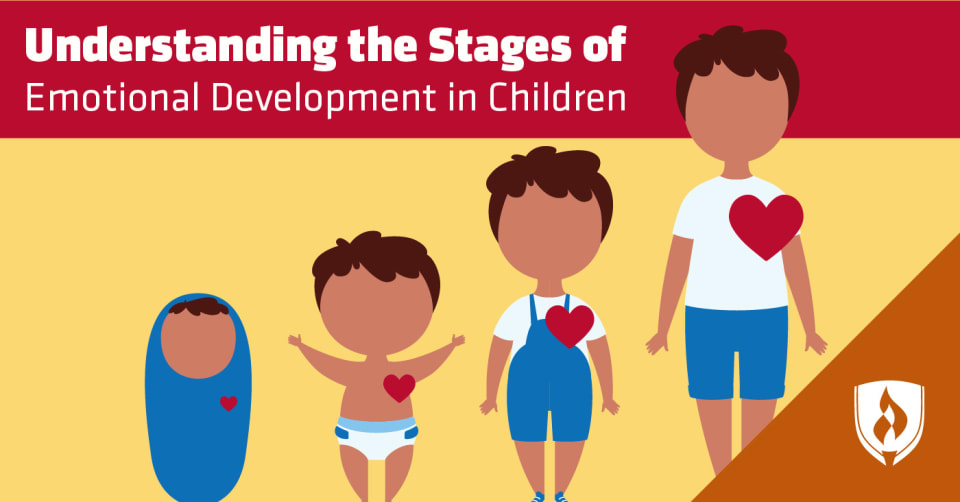
Emotions are what help us derive meaning from the world around us. Without them, we would experience life with the vibrancy of reading a technical manual on transmission repair. While our emotions—whether good or bad—provide a lot of the excitement in life, there’s still a lot about them that we don’t know.
Researchers have been studying emotions for decades and there are still plenty of questions left unanswered. That said, we know that emotional development is key to living a healthy life. So what can be done to help facilitate this emotional growth in young children? We asked parents, psychologists and educators to tell us everything they know about this process, including caregiver tips for each stage.
Every child is unique and develops a little differently, but overall, there are three major steps to building a well-equipped, emotional toolbox—and they don’t just happen. They involve practice and support from those who understand how important emotional intelligence really is. One crucial aspect of this development is social referencing. Learn more about the role of social referencing in child development here.
Why is teaching emotional development important?
Can you remember the first time you shared your favorite childhood toy? Maybe you noticed someone who needed cheering up. What would have caused a meltdown before, you now do willingly. You might not have known it at the time, but that was a big step in your own emotional growth—and that growth was significantly guided by the adults in your life.
According to the National Center for Safe and Supportive Learning Environments, strong emotional development leads to five key skills: self-awareness, social-awareness, emotional regulation, responsible decision making and relationship building. These skills in turn influence success at school, at home, in communities and in society.
On the other hand, those who are not given emotional guidance often struggle emotionally, academically, physically, and behaviorally. If you cannot notice, express and manage your emotions, it is incredibly difficult to focus on school, make friends or work on a team.
Emotional development affects all development, and, given the small window of incredible growth in children before the age of five, it is crucial to cultivate from the very beginning.
3 Major emotional stages in childhood development
Take a closer look at three critical stages of emotional development so you can be equipped to help support the children you care for.
1. Noticing emotions: Birth to one
There are a lot of different theories about how emotions develop and function. Some think we are born with only three emotions: happiness, anger and fear. Others believe that babies are capable of feeling a much wider range from birth. It’s impossible to know for sure when they can’t tell us, but through crying and cooing, babies certainly communicate something. At this stage, an infant is discovering the world—good things like cuddles, bad things like full diapers. They are noticing how everything makes them feel.
How to foster growth in this stage
Create a safe, consistent environment. This is the launch pad from which children can feel confident enough to explore and express themselves. When they know that you will be there for them, they are more likely to take the risks necessary for development.
Adina Mahalli, family care specialist from Maple Holistics, believes that to create this environment, fostering healthy relationships is first and foremost.
“Children are born with the need and desire to connect with those around them,” Mahalli says. “When caregivers establish positive relationships with children during the early years, children feel safe and secure, laying the foundation for healthy social and emotional development.”
Encourage self-soothing. Though some are quick to discourage behaviors like thumb sucking, this helps children soothe themselves and is the first step to regulating emotion. It can be difficult not to step in and fix the issue, but if you want a child to be able to manage their emotions later on, it is important to let them figure some things out on their own.
Show your emotion. No matter what stage, children mirror their caregivers. By matching a child’s facial expressions and vocalizing your feelings, you can help a child notice both their emotions and yours. This will also help you practice being an emotional role model.
Kate Tunstall, creator of the lifestyle and parenting site The Less-Refined Mind, argues that these small actions can have a significant impact. “The single biggest influence on the behavior of children of any age is how we as parents respond to big emotions. Our kids will emulate us, so the most critical way to help them regulate their emotions and responses is to model desirable behaviors ourselves.”
2. Expressing emotions: Two to three
As children develop a vocabulary and more independence, they will experiment with expressing emotion in new ways. Some of it will be productive like drawing and narrating a picture of the scary monster under the bed. Some of it will be more like throwing a tantrum in the grocery store because they can’t get cheese puffs. This can be a very difficult stage for adults as children experience complex emotions but have not yet figured out healthy versus unhealthy expression.
How to foster growth in this stage
Stay calm when they aren’t. Tantrums will happen. They are a normal part of development. As a toddler’s feelings outrun their ability to express them, they will do so in the only way they know how. Your job is to help them find a better way, and you can’t do that when you’re giving into tantrums or having one yourself.
Dr. Fran Walfish, family and relationship psychotherapist, suggests directing your child’s anger or frustration with “clarity, kindness, empathy and firmness.” The first thing to remember is that—as trivial as they may seem—a child is always entitled to their emotions. Instead of pointing out how absurd it is to be angry when you’ve warned them that screen time is coming to an end, validate why they’re mad.
“Be empathetic toward your child at how hard this moment is for him or her,” Dr. Walfish suggests. This approach coupled with praise for completing the (relatively) hard-to-do tasks that have upset them is a model for helping children understand that frustrations happen, but what matters most is how you handle them.
Give them language to name and explain. The best alternative to having a tantrum is being able to express emotion through words. If a child can say, “I’m angry,” or even better “I’m angry because he took my toy,” they can focus on putting words to their feelings rather than melting down. This can, in turn, help them feel more in control of their emotions.
One of the best ways to help children learn about emotion is through story. This not only provides emotional vocabulary but puts it into a creative context. Melissa Hart, parent and author, offers some helpful suggestions. “Many educators and parents use books to foster emotional development in children. There are wonderful picture books like When Sadness Is at Your Door, Odd Dog Out, and Be Who You Are that spark conversations about emotions and give young people the words to express their feelings.”
Provide positive reinforcement. There is certainly a time for the words “No,” “Don’t,” and “Stop,” but if those are the only words you use, they can quickly lose power. Celebrate the little ways that children make progress. By pointing out when they use their words or actions to positively express themselves instead of screams and kicks, you can build their self-confidence and encourage them to grow.
3. Managing emotions: Three to five
At this stage, children are ready to enter preschool. A new social environment and more independence provides a great opportunity for growth but also poses some new challenges. Sharing, listening and playing together can cause friction between children, and since they cannot rely on their parents all the time anymore, they must develop new coping skills to manage on their own. Preschool caregivers play a vital role in this development as they create a safe space and offer guidance.
How to foster growth in this stage
Give them strategies. Just as infants suck their fingers or clutch their blankets, preschoolers use tangible ways to deal with their intangible emotions. Going to a quiet place, deep breathing, and coloring are all good strategies. The goal is to help children learn what works for them. Do they need to be alone, have a conversation or be distracted before they can process their feelings? Doing this before a child gets upset can go a long way toward influencing their behavior when they are.
Laura Morlok, licensed clinical professional counselor from Playful Therapy Connections, suggests also demonstrating these strategies yourself. “You can support your child in managing their emotions by modeling coping strategies and then practicing them together. ‘I'm feeling angry because I dropped the bowl and it broke. I think I need to take some deep breaths. Can you take some deep breaths with me?’” This can help a child better understand how and when to apply coping strategies.
Have realistic expectations. If you expect too much from a child, you’re going to be disappointed and frustrated. Too much of this and a child will start to associate shame and anxiety with their emotions—something that can hurt their future development. On the other hand, if you expect too little, a child may learn unhealthy behaviors instead of developing effective skills. This is why it is so important to be aware of the different emotional stages. If you know that two-year-olds will have tantrums, it's much easier to empathize with them and help them take the next steps in processing what’s upset them.
Evan Porter, creator of the parenting blog Dad Fixes Everything, admits that his own parenting benefits from understanding what is normal for his daughter. “Probably one of the biggest things I've learned is that she needs lots of room to experience and work through her feelings. It's hard for me, because I'm a fixer and I want to make her feel better when she's upset, but there's really no way to short circuit the process. She has to get the feelings and the tears out before we can have a constructive conversation about what happened and how to handle it better next time, and sometimes that takes a while.”
Validate. Validate. Validate. In order for a child to know that an emotion is manageable, they must first know that it is normal. If they feel like they’re the only one who experiences frustration, they are more likely to believe that they are helpless to it. Say things like, “This is very frustrating. I would be frustrated too.” You can show them that feeling frustrated isn’t bad while also normalizing their experience. This validation is key to building both self-confidence and a healthy response to emotion.
Help children find the tools they need to thrive
It doesn’t take many trips around the sun to know that even adults struggle with noticing, expressing and managing their emotions at times. The process of emotional development is not a straight line. Some days, you may need to encourage yourself, but having a good emotional toolbox will make all the difference. You could be the one to help children find the skills they need to fall back on when life gets tough, and, perhaps even better, you could show them just how meaningful life is when you pay attention to the way it makes your breath catch, your stomach turn, and your heart race.
You might think early childhood education is just about getting kids comfortable with the academic basics—shapes, colors, counting—but in reality, early childhood educators play an important role in helping children develop emotionally and more. Learn more about early childhood education in our article, “5 Reasons Why the Importance of ECE Is Impossible to Ignore."
Related Articles:
- Toddlers and Technology: A Guide for Responsible Introduction to Devices
- What Is Early Childhood Intervention? What ECE Professionals Should Know
Graduates of Early Childhood Education programs at Rasmussen University are not eligible for licensure as a teacher in an elementary or secondary school. A Bachelor’s degree and a state teaching license are typically required to work as a teacher in a public school and some private school settings. States, municipalities, districts or individual schools may have more stringent licensing requirements. Students must determine the licensure requirements in the state and school in which they intend to work.
Childcare facilities and the states in which they are located establish qualifications for staff who work with children, and often implement guidelines regarding age, education, experience and professional development. Students must determine the licensure requirements for the state and facilities in which they work.
This program has not been approved by any state professional licensing body, and this program is not intended to lead to any state-issued professional license. For further information on professional licensing requirements, please contact the appropriate board or agency in your state of residence.




